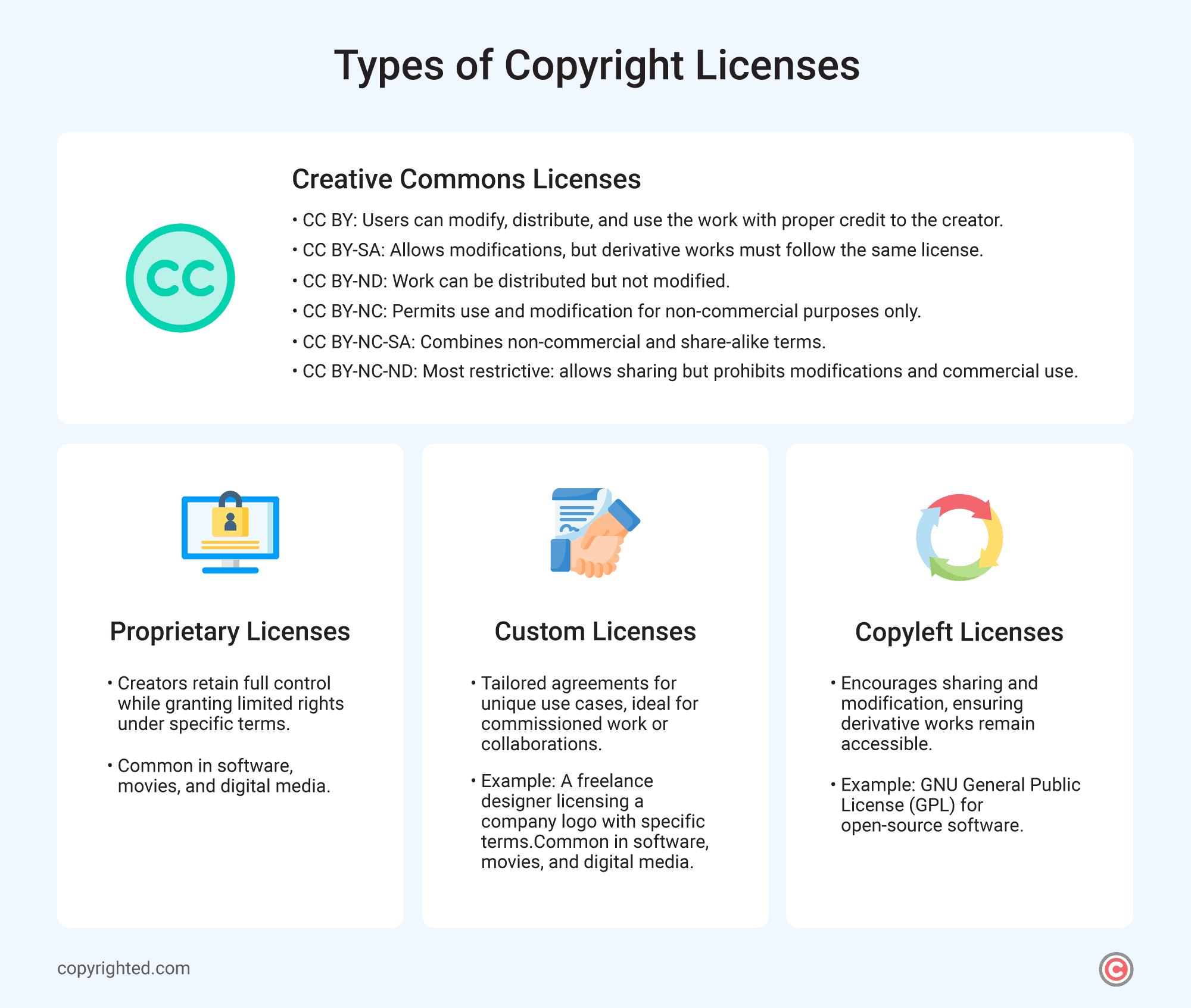Knowing how copyright licenses work is essential if you’re a creator protecting your intellectual property or someone looking to use content legally. Copyright licenses define how creative works, such as music, art, software, or writing, can be used, shared, or modified.
However, not all licenses are created equal. Some offer significant freedom, while others impose stricter limitations.
Failing to understand these differences might lead to legal trouble or loss of control over your creations.
The article below outlines the main types of copyright licenses in a simple and straightforward way. By the end, you’ll have the tools to make informed choices as a creator, user, or both.
- Different copyright licenses, such as Creative Commons, proprietary, custom, and copyleft, offer varying levels of control and flexibility over creative works.
- Choosing the right license requires evaluating factors like control, commercial purposes, audience, collaboration goals, and legal clarity.
- Multi-licensing allows creators to offer their work under different terms to reach diverse audiences, balancing personal and commercial use.
Table of Contents
What Are the Types of Copyright Licenses?
Copyright licenses are legal agreements that determine how a creator’s work can be used, shared, or adapted. These licenses can be categorized into exclusive and non-exclusive licenses.
In exclusive licenses, the copyright owner grants rights to a single licensee, excluding everyone else, including the copyright holder. These are common in publishing or production agreements.
For example, an author might grant an exclusive license to a publisher for a book’s distribution.
On the other hand, in non-exclusive licenses, the copyright holder allows multiple parties to use the work simultaneously. This is typical in Creative Commons or open-source licensing, where the creator retains ownership but permits broad use.
Below are the most common types of copyright licenses.

Creative Commons (CC) Licenses
Creative Commons licenses are standardized agreements designed to help creators share their original work while retaining some rights. They are widely used for content like blogs, educational materials, and media.
Here are the types of Creative Commons licenses:
- CC BY: Users can use, distribute, and modify the work as long as credit is given to the creator.
- CC BY-SA: Similar to CC BY, it requires users to license their derivative works under the same terms.
- CC BY-ND: Allows distribution but prohibits modification.
- CC BY-NC: Permits use and modification for non-commercial purposes only.
- CC BY-NC-SA: Combines non-commercial use with share-alike terms.
- CC BY-NC-ND: The most restrictive—users can share but not modify or use commercially.
Proprietary Licenses
Proprietary licenses restrict how a work can be used, offering limited rights under specific conditions. These licenses are common in commercial products like software, movies, and digital media.
They ensure that the creator retains full control over their work while granting access or usage rights to users who follow the terms. For example, Microsoft Office and Adobe Creative Suite are distributed under proprietary licenses.
Custom Licenses
Custom licenses are agreements tailored to meet specific requirements between creators and users. This license allows creators to define unique terms that standard licenses may not cover, making it ideal for special projects or collaborations.
It is often used for commissioned art, custom software solutions, or corporate branding materials. For instance, a freelance designer might license a company to use a logo under specific conditions.
Copyleft Licenses
Copyleft licenses are designed to encourage the sharing and modification of works while ensuring that derivative works remain accessible under the same terms.
These licenses are widely used in open-source software and educational resources, promoting collaboration and accessibility.
For example, the GNU General Public License (GPL) allows users to modify and redistribute software, provided the modified versions are also released under the same license.
How to Choose the Right License for Your Work
Choosing the right copyright license depends on your goals, the nature of your work, and how you want others to interact with it.
Here are the key factors to consider:
1. Your Intended Level of Control
Decide how much control you want over your work.
If you want to allow widespread use, modification, and sharing, consider open licenses like Creative Commons (CC) or Copyleft licenses. For tighter control, proprietary or exclusive licenses may be more suitable.
2. Commercial vs. Non-Commercial Use
Think about whether you want to allow others to use your work for profit.
Open licenses like CC BY-NC restrict commercial use while permitting other applications. Proprietary licenses or custom agreements may help you monetize directly through licensing fees.
3. The Nature of Your Audience or Market
Consider who is likely to use your work and how they might interact with it.
Creative Commons is popular among educators, researchers, and artists who share work for the public benefit. Custom Licenses are often needed for businesses with unique terms or requirements.
4. Collaboration and Adaptation Goals
If you encourage collaboration and derivative works, choose licenses like CC BY-SA or Copyleft licenses, which require derivative works to stay under the same licensing terms. If you prefer your work to remain unchanged, opt for licenses like CC BY-ND or proprietary agreements.
5. Legal Compliance and Clarity
Ensure the license aligns with applicable copyright laws and that terms are clearly defined. Using established licenses like Creative Commons simplifies compliance and avoids misunderstandings.
6. Future Flexibility
Consider whether your goals may change.
For example, an exclusive license can limit your future ability to republish or reuse your work. Non-exclusive or open licenses provide more flexibility for adapting to new opportunities.
Can a Work Have Multiple Licenses?
Yes, a work can have multiple licenses. This allows creators to offer the same work under different terms based on users’ needs.
Multi-licensing offers flexibility, letting creators reach both casual and commercial users. For instance, software can be free for personal use under an MIT license but requires a commercial license for enterprise use.
Similarly, a photographer might allow personal use under a Creative Commons license but charge for commercial usage.
While U.S. copyright law doesn’t explicitly mention multi-licensing, it permits copyright holders to grant permissions as they choose. Clear communication of terms is essential to ensure users understand their options and responsibilities.
Frequently Asked Questions
Can a copyright license be revoked?
Yes, if the terms of the agreement allow for revocation or if the licensee violates the terms.
Can you license a work that is in the public domain?
No, works in the public domain cannot be copyrighted or licensed, as they are free for unrestricted use.
Can you change the type of license for your work later?
Yes, you can change the license type, but the change only applies to future distributions, not past ones.
What is the most flexible type of copyright license?
The CC BY license is among the most flexible, allowing modifications, distribution, and use with attribution.
How can you terminate a copyright license?
A copyright license can be terminated if the licensee violates the terms or if the agreement specifies termination clauses.


